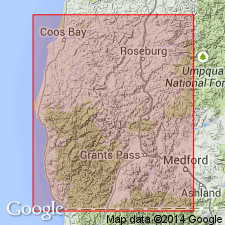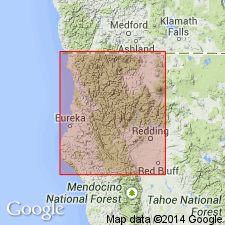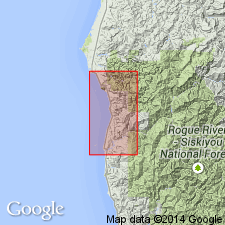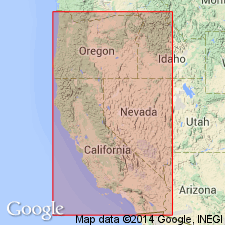
- Usage in publication:
-
- Saddle Mountain diorite
- Modifications:
-
- Named?
- Geochronologic dating
- Dominant lithology:
-
- Diorite
- AAPG geologic province:
-
- Klamath Mountains province
Summary:
[Probably named for Saddle Mountain which is 3 mi north of Collier Butte, Curry Co, OR.] Sample from Saddle Mountain diorite, collected 1.5 mi west-northwest of Saddle Mountain (T37S R12N), gave apparent isotopic age on hornblende of 285 +/-25 Ma. Considered anomalously high.
Source: GNU records (USGS DDS-6; Menlo GNULEX).

- Usage in publication:
-
- Saddle Mountain Diorite
- Modifications:
-
- Geochronologic dating
- AAPG geologic province:
-
- Klamath Mountains province
Summary:
Hornblende ages of 285 Ma, 275 Ma, and 215 Ma are cited by Dott(1965) for Saddle Mountain Diorite, Pearse Peak Diorite and mafic rock in southwestern OR, respectively. Ages appear to be anomalously old for rocks apparently intrusive into western Jurassic subprovince, but their striking similarity to ages on Pit River Diorite and Salmon Hornblende Schist (286 to 218 Ma) lends them credence. Dott (1965) suggested that dike rock and Saddle Mountain Diorite may be crustal material brought up along fault zones in ultramafic rock with which they are associated. Field relationships of Pearse Peak, however, are described by Dott as inconsistent with this explanation. An alternative explanation for Pearse Peak pluton is that dioritic basement rocks of Paleozoic age were remobilized and intruded to higher crustal levels during Late Jurassic orogeny. This possibility would be in accord with younger biotite-defined age for Pearse Peak pluton (145 to 141 Ma) and other radiometric evidence for Late Jurassic metamorphism and igneous intrusion in southwestern OR area.
Source: GNU records (USGS DDS-6; Menlo GNULEX).

- Usage in publication:
-
- Saddle Mountain diorite
- Modifications:
-
- Geochronologic dating
- AAPG geologic province:
-
- Klamath Mountains province
Summary:
Discussion of radiometric dating of diorite units in southwestern Oregon. Seemingly anomalous ages have been obtained from some hornblende concentrates, for example, 285 +/-25 Ma age for Saddle Mountain diorite.
Source: GNU records (USGS DDS-6; Menlo GNULEX).

- Usage in publication:
-
- Saddle Mountains pluton
- Modifications:
-
- Geochronologic dating
- AAPG geologic province:
-
- Klamath Mountains province
Summary:
"Dioritic to gabbroic rocks that are considered to be part of the mafic-ultramafic complex yield K-Ar isotopic ages that are considerably older than would be expected for the Coast Range ophiolite." Of these, Saddle Mountain pluton in Snow Camp peridotite gave an age of 285 Ma.
Source: GNU records (USGS DDS-6; Menlo GNULEX).
For more information, please contact Nancy Stamm, Geologic Names Committee Secretary.
Asterisk (*) indicates published by U.S. Geological Survey authors.
"No current usage" (†) implies that a name has been abandoned or has fallen into disuse. Former usage and, if known, replacement name given in parentheses ( ).
Slash (/) indicates name conflicts with nomenclatural guidelines (CSN, 1933; ACSN, 1961, 1970; NACSN, 1983, 2005, 2021). May be explained within brackets ([ ]).

